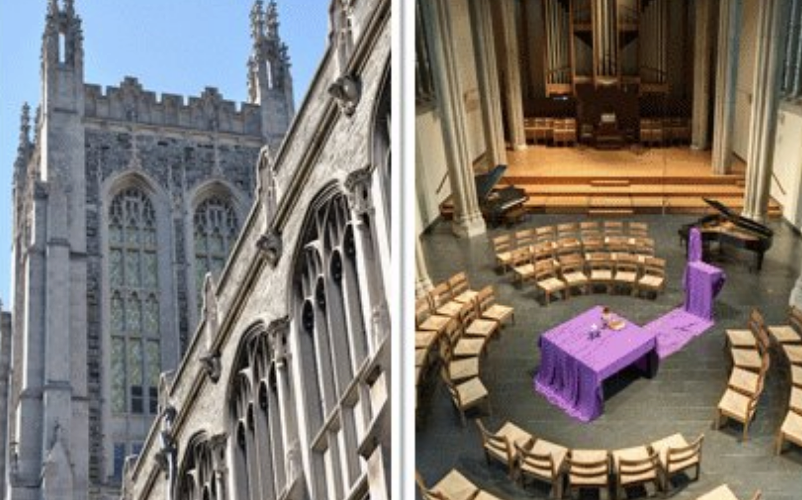Today in chapel, we confessed to plants. Together, we held our grief, joy, regret, hope, guilt and sorrow in prayer; offering them to the beings who sustain us but whose gift we too often fail to honor.
What do you confess to the plants in your life? pic.twitter.com/tEs3Vm8oU4
— Union Seminary (@UnionSeminary) September 17, 2019
Yes, this was click-bait heaven.
Yes, this was an oh-so-typical Twitter storm.
Yes, this was a perfect example of a “conservative story,” in a niche-news era in which social-media choirs — conservative in this case — send up clouds of laughs, jeers and gasps of alleged shock in response to some online signal.
I am referring, of course, to that climate-change confession service that happened at Union Theological Seminary, which has long been a Manhattan Maypole for the doctrinal dances that incarnate liberal Protestant trends in America.
It’s important to note that the spark for this theological fire was an official tweet from seminary leaders. Here is the top of a Washington Examiner story about the result:
Students at Union Theological Seminary prayed to a display of plants set up in the chapel of the school, prompting the institution to issue a statement explaining the practice as many on social media mocked them.
“Today in chapel, we confessed to plants,” the nation’s oldest independent seminary declared Tuesday on Twitter. “Together, we held our grief, joy, regret, hope, guilt and sorrow in prayer; offering them to the beings who sustain us but whose gift we too often fail to honor. What do you confess to the plants in your life?”
The ceremony, which is part of professor Claudio Carvalhaes’ class “Extractivism: A Ritual/Liturgical Response,” drew ridicule from many on Twitter, some of whom accused the seminary and students of having lost their minds.
OK, let’s pause for a moment to ask a journalism question: Would there have been a different response if this event have inspired a front page, or Sunday magazine, feature at The New York Times?
What kind of story? A serious news piece could have focused on (a) worship trends on the revived religious left, (b) this seminary’s attempt to find financial stability through interfaith theological education, (c) the history of Neo-pantheistic Gaia liturgies in New York (personal 1993 flashback here) linked to environmental theology and/or (d) all of the above.
In other words, Union remains a highly symbolic seminary — even as it strives to survive with a mere 222 students and 25 full-time faculty (while sitting on prime property in the Morningside Heights neighborhood next to Columbia University). It has been an important institution ever since 1891, when the seminary exited the mainline Presbyterian church of that day after its Bible department chair questioned the verbal inspiration of scripture (a boringly common liberal belief today).
In other news, writers for @TheBabylonBee and @EyeOfTheTiber were found curled up on the floor in fetal positions sobbing uncontrollably about their life choices https://t.co/wLIoFhyy7h
— Steven D. Greydanus (@DecentFilms) September 18, 2019
To it’s credit, the Examiner team did let the seminary’s current leadership speak its mind, as expressed in a long, long Twitter sermon.
“We’ve had many questions about yesterday’s chapel,” the statement read in part. “In worship, our community confessed the harm we’ve done to plants, speaking directly in repentance. This is a beautiful ritual.”
“We are in the throes of a climate emergency, a crisis created by humanity’s arrogance, our disregard for Creation,” the statement continued. “Far too often, we see the natural world only as resources to be extracted for our use, not divinely created in their own right — worthy of honor, thanks and care. We need to unlearn habits of sin and death. And part of that work must be building new bridges to the natural world. And that means creating new spiritual and intellectual frameworks by which we understand and relate to the plants and animals with whom we share the planet.”
Encouraging churches to turn from “theologies that encourage humans to dominate and master the Earth,” Union asserted that “we must birth new theology, new liturgy to heal and sow, replacing ones that reap and destroy.”
“No one would have blinked if our chapel featured students apologizing to each other,” the statement went on. “What’s different (and the source of so much derision) is that we’re treating plants as fully created beings, divine Creation in its own right — not just something to be consumed. Because plants aren’t capable of verbal response, does that mean we shouldn’t engage with them? So, if you’re poking fun, we’d ask only that you also spend a couple moments asking: Do I treat plants and animals as divinely created beings?”
The key? This liturgical rite wasn’t all that unusual, in terms of Union chapel services:
“One day, you may come in to find a traditional Anglican communion, another day you may enter into a service of Buddhist meditation or Muslim prayer,” the spokesperson continued. “Another, you may find a Pentecostal praise service or a silent Quaker meeting. We create a home where people can worship side by side, in traditions similar to and very different to their own. Through this process, we learn from our neighbors and discern our own faith more deeply.”
Once again, readers can catch a glimpse of a perfectly valid news story rooted in this question: What does truly interfaith seminary education look like? What doctrines form the core of this institution’s worldview?
The seminary website, after all, notes that its student body includes (or, I assume, has recently included) students in the following traditions: Baptist, pagan, African Methodist Episcopal (Zion), Buddhist, Hindu, Episcopal, Catholic, Lutheran, Jewish, Muslim, Church of Christ, Friends-Quaker-Mennonite, Unitarian Universalist, Orthodox, Reformed Church in America and Seventh-day Adventist. I have to ask: There are no United Methodists in the mix?
Here’s a symbolic question for reporters to pursue: How many times a week is the chapel reorganized, in terms of religious symbols and format? Is there a kind of liturgical closet nearby containing the various items needed to symbolize all of these identities?
Here’s an even more important story: What denominations send offering-plate dollars to this institution, either in grants or via checks that support the studies of seminarians preparing to be ordained in these flocks? Yes, reporters could follow the money.
I have been looking for mainstream news coverage of this Twitter storm and, so far, I am coming up empty. I would appreciate notes from readers alerting me to news coverage — reporting, not commentary — that I have missed.
There will be many opinions expressed. The Washington Post weighed in with an opinion essay by Veery Huleatt, senior editor for Plough Quarterly. Here is a key passage, focusing on the original Union message:
“Christian Twitter” is always on fire about something, and today that tweet was its sacrificial fuel. Detractors saw in it everything from idolatry to New Age nonsense to an opportunity for jokes about “VeggieTales” and church plants.
But beneath the very human tendency to jump on the virtual bandwagon, I think there is a pressing question that many Christians and people of no faith are grappling with: What is our moral responsibility to nonhuman life-forms? If we can sin against the natural world, how do we name and atone for that sin?
Confession is the Christian response to guilt. While it takes various forms in different traditions, confession is a private or public acknowledgment of sins as the first step in repentance and reconciliation with God and the church.
That leads to one final question that is relevant to this story.
Did this rite ask Union students to confess their sins to the plants or were the prayers offered to God, expressing repentance for sins committed against God’s creation? Or did the liturgists attempt to do both, in light of this seminary’s unique body of believers?
This theological distinction would matter to many readers and, maybe, a few seminary donors. Trust me: There is real news to be found here, as well as click-bait offerings.
FIRST IMAGES: From the Union Theological Seminary Facebook page.










